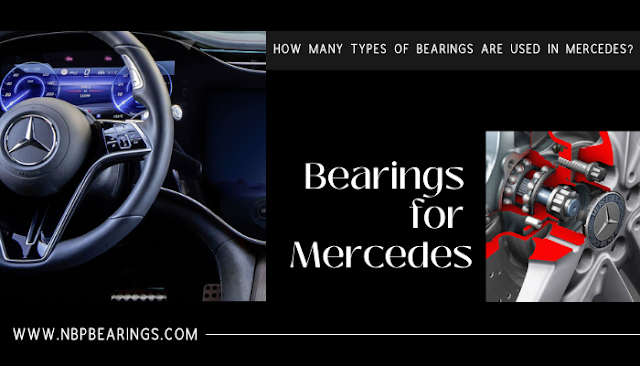How many types of bearings are used in Mercedes?
Introduction:
Mercedes-Benz, renowned for its luxury and engineering excellence, utilizes a wide range of high-quality components to ensure superior performance and durability in its vehicles. Among these components, bearings play a critical role in supporting various mechanical systems and enabling smooth movement. Bearings are crucial for reducing friction and facilitating the rotation of parts, enhancing efficiency and reliability. In this article, we will delve into the different types of bearings commonly used in Mercedes vehicles, their functions, and their significance in ensuring optimal performance.
Ball Bearings:
Ball bearings are one of the most commonly used types of bearings in Mercedes vehicles. They consist of an outer ring, an inner ring, a cage, and steel balls that are placed between the rings. The smooth, round balls facilitate rotational movement and help distribute the load evenly. Ball bearings are utilized in various components throughout the vehicle, including:
Wheel Bearings: Wheel bearings in Mercedes vehicles support the weight of the vehicle and allow the wheels to rotate smoothly. They endure significant forces and ensure safe and stable driving.
Engine Components: Ball bearings are used in critical engine components such as the crankshaft, camshaft, and connecting rod bearings. These bearings reduce friction and allow the engine to run smoothly, enhancing efficiency and performance.
Alternator and Starter Motor: Ball bearings are also utilized in the alternator and starter motor, where they facilitate the smooth rotation of these components, ensuring reliable operation and electrical power generation.
Roller Bearings:
Roller bearings are another commonly used type of bearing in Mercedes vehicles. They are designed to handle heavier loads and provide increased support compared to ball bearings. Roller bearings feature cylindrical or tapered rollers that distribute the load over a larger contact area, reducing friction and enabling smooth motion. Some key applications of roller bearings in Mercedes vehicles include:
Transmission System: Roller bearings are utilized in the transmission system to support various gears, shafts, and synchronizers. They allow smooth gear shifting and contribute to the overall efficiency and durability of the transmission.
Differential System: Roller bearings are essential components in the differential system of Mercedes vehicles. They support the rotational movement of the differential gears and ensure optimal power distribution to the wheels.
Suspension Components: Roller bearings are used in the suspension system to support and facilitate the movement of components such as control arms, strut mounts, and suspension linkages. They help absorb shocks and vibrations, ensuring a comfortable ride.
Plain Bearings:
Plain bearings, also known as bushings or sleeve bearings, are utilized in Mercedes vehicles where rotational movement is not required but smooth sliding is necessary. These bearings consist of a cylindrical metal sleeve with a low-friction surface, often made of materials such as bronze, graphite, or plastic. Plain bearings are commonly found in various applications, including:
Suspension System: In Mercedes vehicles, plain bearings are used in suspension components such as control arms and sway bar links. They provide smooth and friction-free movement, contributing to enhanced handling and ride comfort.
Engine Components: Plain bearings can be found in engine components like the crankshaft pulley and idler pulley. They reduce friction and ensure the reliable operation of these rotating parts.
Power Steering System: The power steering system in Mercedes vehicles also incorporates plain bearings to facilitate smooth movement in the steering column and rack, enhancing maneuverability and responsiveness.
Thrust Bearings:
Thrust bearings are specifically designed to handle axial loads, providing support for components subjected to thrust forces. These bearings consist of rolling elements, typically balls or rollers, housed within a raceway. Thrust bearings are utilized in Mercedes vehicles for applications such as:
Clutch System: Thrust bearings are crucial components in the clutch assembly. They support the clutch release mechanism, allowing smooth engagement and disengagement of the clutch, resulting in efficient power transfer.
Transmission System: Thrust bearings are also employed in the transmission system to support various shafts and gears subjected to axial loads. They ensure smooth and reliable gear shifting.
Differential System: Thrust bearings are used in the differential system to support the differential gears and handle the thrust forces generated during cornering or uneven traction conditions.
Conclusion:
Bearings for mercedes vehicles are built with precision and engineering excellence, and the selection of appropriate bearings is vital to their performance and reliability. The various types of bearings, including ball bearings, roller bearings, plain bearings, and thrust bearings, play integral roles in supporting critical components and systems throughout the vehicle.
From facilitating smooth wheel rotation and minimizing friction in the engine components to supporting gear shifting and providing comfort in the suspension system, bearings are essential for the optimal functioning of Mercedes vehicles. Each type of bearing is carefully chosen based on the specific application requirements, load capacity, and operational conditions.
By incorporating high-quality bearings, Mercedes ensures that its vehicles deliver a superior driving experience, exceptional performance, and longevity. These precision-engineered bearings contribute to the overall reputation of Mercedes-Benz for luxury, comfort, and reliability.



.png)
Comments
Post a Comment